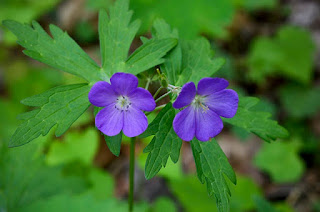Smith Gilbert Gardens is 13 acres of peace. Located in busy Kennesaw, its heart beats with love and gentleness. We have gone to many hidden places to find wild specimens, but SGG calls out to us. In one place, you can visit an historic home, outdoor sculpture, vegetable beds, and the gardens. And it is the gardens, of course, that are so magnificent.
For those of you who may not know, the house and gardens are a work of love by our own Dr. Bob Gilbert and his late partner Richard Smith. In 30+ years, they changed a bedraggled site that was falling apart to one brimming with life and beauty.
We had the insight of a long-time guide, Jo-Evelyn Morris, while we took our tour. Her stories and comments made the tour even more enlightening. This garden has a birthplace, and Jo-Evelyn took us there. At the edge of the birthplace are five Tibetan prayer flags inscribed with messages that are meant to bring happiness, long life and prosperity to those in their vicinity. The colors represent the elements of earth, water, fire, cloud and sky. As the soft cloth tatters in the breeze, printed prayers float into the world.
As we moved about the gardens, we saw the perennial garden and Knowlton Meadow. We also saw the Japanese Maple Grove, with its 30 varieties of the medium-sized tree, and the Camellia Garden. They all are full of ideas and plants for the home gardener to try. One idea that was popular with us was using wrought-iron stakes to hold up heavy peony heads.
One of the most esthetic sites is the Mulberry Bowl. There is a gorgeous mulberry tree there that you could look at for hours. It has the marks of a long and challenging life. The mulberry is considered a trash tree, but this example shows how wrong that notion is. As if to confirm this, there is a sculpture titled “Respite,” which is situated across from the tree and appears to be staring at it. The site’s mulberry is a very old tree, but here’s hoping it endures for many more years.
The Rock Garden is not to be missed, either. It is modeled after a garden in Scotland, but transformed into a garden that would flourish in our tropical climate. There are low-growing plants, sculpture, a tea house, and stately koi that swim in the ponds and waterfall.
The Rose Garden is part of the Cedar Field and offers a rest after walking through the gardens. The roses are spectacular, with fragrance and beauty that people have loved for centuries. There are dozens of varieties of roses in this garden and right now the roses are at their peak. It is a gorgeous sight to see.
The Bonsai Garden comes at the end of the tour, and it is worth the wait. This Bonsai Garden is the only one of its kind displayed publicly in the state of Georgia. Each tree tells a story, but you have to listen closely to hear it.
In all, a day spent touring SGG is a day well spent. You will finish the day filled with a sense of beauty and free of stress.



















































